How To Set Up Utilities For The First Time in Japan
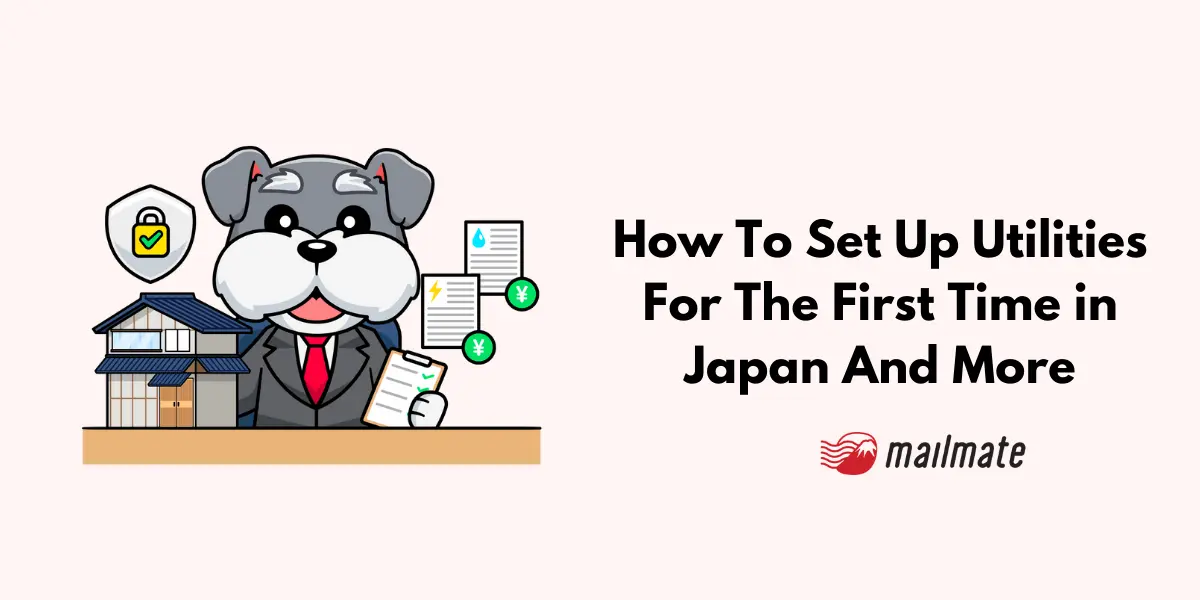
Setting up utilities is one of the first steps you'll undertake when moving into a new apartment, house, or akiya in Japan.
Applying for utilities is easy but can be stressful if you do not speak Japanese.
Today, we'll explain what you need to know to set up utilities for the first time in Japan to make the process less stressful.
What kind of utilities need to be set up beforehand?

Water, electricity, and gas are common utilities to set up before your move-in date.
After moving in, other utilities, such as internet, telephone, and cable TV, can be set up.
What to know before applying for utilities in Japan
Before you move into your new place in Japan, you should apply for your utilities at least two weeks before your move-in date.
The real estate company you are working with will have given you information on which utility company to contact.
Utility companies will need the following information to process your application:
Full name
Address
Date to start the service
Phone number
Many major utility companies have an online application that you can use to get your utilities switched on.
Note: We recommend registering for essential utilities in Japan before moving into your new home or apartment to avoid getting stuck without access to water, gas, or electricity.
How to find your utility providers
In general, the real estate agent or the property management company you are working with will have a list of utility providers for you to use.
In some cases, there may be only one option for electricity, gas, and water.
Alternatively, you can search for available providers by typing [location] 電気・ガス・水道 into Google Search.
How to set up utilities for the first time as a foreigner
If you're setting up utilities in Japan as a foreigner, some (not all) utility providers will have an English application for you to fill out to start using their service.
If they don't have an English application, use Google Chrome's translation feature to fill out and submit your form in Japanese.
Alternatively, you can use MailMate's bilingual property management service that will provide utility liaison service in English.
Step-by-step guide for setting up utilities in your new home
How to set up electricity in Japan
Step 1: Apply online or by phone to your regional electricity provider.
Depending on your location, you can combine your electricity and gas utilities into one bill, which may provide a slight discount on the total amount and make it easier to manage one invoice instead of two.
Step 2: Choose the amperage plan.
When applying for electricity, you'll need to decide the amperage, or the amount of electricity, which will form the basis of your plan rate.
The standard is 30 amperage, but the electricity company may offer different plans to accommodate different lifestyles.
Step 3: Schedule an activation appointment if necessary.
Depending on the property, a staff worker may come in person to turn on the electricity and check the meter. In other cases, you may be able to turn on your electricity yourself.
Note: Remember to pay your electric bill on time. Otherwise, there’ll be a late fee, and, worst case, your electricity will be cut off.
Common electricity providers in Japan
Here are common electricity company providers that many foreigners use:
Tokyo and Yokohama: TEPCO (Tokyo Electric Power Company)
Fukuoka: KYUDEN (Kyushu Electric Power)
Osaka and Kyoto: KEPCO (Kansai Electric Power Company)
Nagoya: Chubu Electric Power Miraiz
Sapporo: Hokkaido Electric Power Company
How to set up gas in Japan
There are two types of gas that apartments and houses use in Japan:
City gas (都市ガス)
Liquid propane (LP Gas or LPガス)
Natural gas is provided by the city, and it is generally cheaper than LP gas.
Step 1: Identify your gas provider.
Ask your real estate agent, or check for provider stickers near your gas meter or stove.
Step 2: Gather required details.
This usually includes your full name, address and move-in date, preferred activation date, phone number and email, and a Japanese contact number.
Step 3: Schedule a technician visit.
When applying for gas in Japan, you must schedule a date for someone to turn on and test your gas line. You must be home for this test, which should take less than 20 minutes.
Unless your property is all-electric (オール電化), be sure to set up your gas when you move in so that you can have running hot water.
Additionally, consider jointly signing up for gas and electricity and combining their cost into one bill.
Common gas utility providers
Tokyo and Yokohama: Tokyo Gas
Fukuoka: Saibu Gas
Osaka and Kyoto: Osaka Gas
Nagoya: Toho Gas
Sapporo: Kita Gas
How to set up water in Japan
Step 1: Find your local water bureau
In Japan, your water service is provided by your prefecture or local municipality. So, complete the application with your local water bureau.
Step 2: Submit your start service application
The application to start and stop the water service is usually online, and you can use your browser's translation feature if you are having trouble in Japanese.
Depending on the property, it might already have running water, but you still must apply for a water service contract under your name.
Step 3: When moving out.
When you move out, don't forget to cancel your contract so that you won't be charged for the next tenant's running water.
Water utility bureaus in Japan
Setting up utilities for an akiya house
In some cases, Akiya houses can be more complex than apartments when setting up utilities, as utility service workers must visit the property to check if there are pipes for water and sewage, correct electrical wiring, pipes for gas, etc.
Strong Japanese communication skills will help you understand the situation and schedule any necessary renovations.
However, if you can’t speak Japanese, consider using MailMate's property management service, which is popular among foreign owners in Japan.
MailMate's service includes the following:
1. Utility liaison
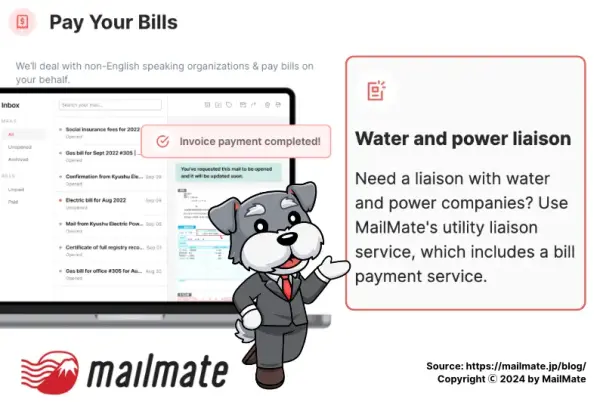
MailMate will contact and coordinate with the respective Japanese utility provider for your property.
They will handle scheduling appointments with the utility service workers and relay information to you, such as whether you need to be at the property during pre-service work and installation day.
Plus, if you are away from your property, you can still receive your bills with MailMate's online dashboard, and they will even pay them on your behalf.
2. Bilingual support
MailMate’s bilingual staff are fluent in Japanese and English, providing a communication bridge to assist you with translation and, most importantly, communication with utility companies, contractors, and local authorities.
When MailMate receives your mail or documents, we provide a translated overview of the incoming mail.
Your mail will be opened, translated, forwarded, and shredded when requested, making the process easier for non-Japanese speakers.
3. Online mail management
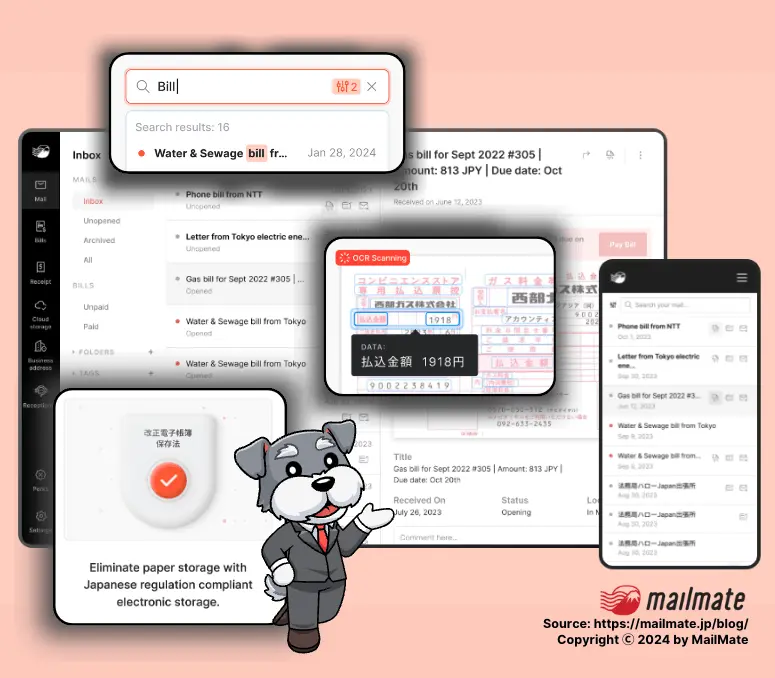
MailMate’s staff will scan incoming mail and documents addressed to your property, allowing you to access bills and manage documents in the cloud.
No more having to sort through your paper piles manually.
Instead, all your postal mail will be digitized, allowing you to search for what you need from the MailMate dashboard.
4. Tax representative
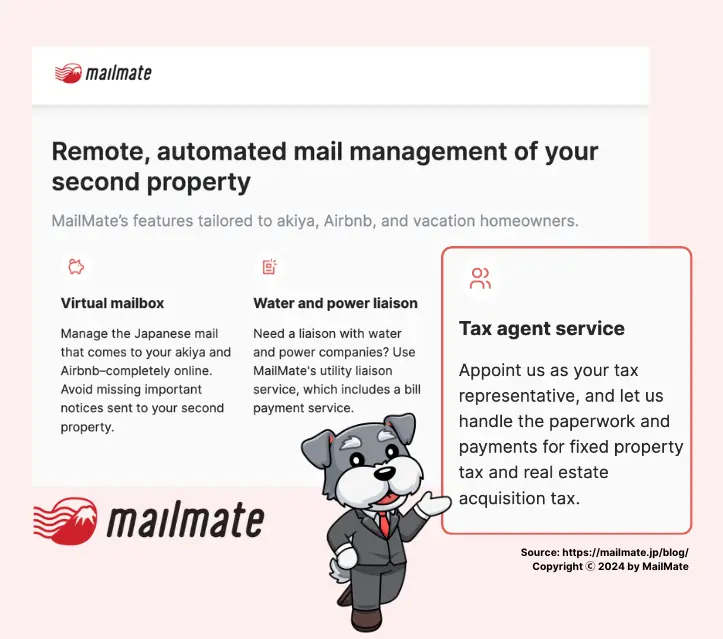
As a property owner in Japan, you are responsible for real estate acquisition tax, fixed asset tax, and city planning tax (if your property is in a city planning zone).
If you reside abroad for most of the year, you are legally obligated to appoint a tax representative for your property to handle your tax bills.
MailMate provides a tax representative service for property owners, which allows them to stay compliant on local tax regulations—even from afar.
Paying your utility bills in Japan
Your utility costs depend on how much energy or water is used during the month. Depending on your preference, there are three ways to pay your bills in Japan.
1. Paying in person
Your utility bills in Japan are delivered to your mailbox every month or two. Usually, gas and electricity bills are delivered monthly, while water can be delivered once every two months.
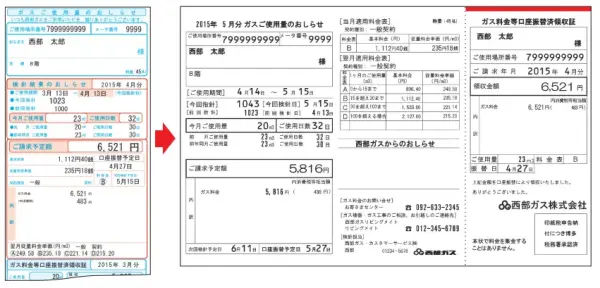
A Seibu gas bill example
The easiest way to pay these paper utility bills is at any konbini in Japan. Show the staff the bill; they’ll scan the barcode, and then you'll pay the amount.
The bill with a payment date stamp will be handed back to you. It acts as proof that you've completed the payment.
2. Automatic withdrawal
This payment option includes bank transfer, as well as credit card, debit card, or online banking. You can pay via this option by switching the payment method on your account.
What's great about bank withdrawals is that you'll never miss a payment. The only downside is that you need a Japanese bank account and card to register.
3. MailMate
If you temporarily leave the country and you need a bill payment service while you’re away, MailMate has your back.
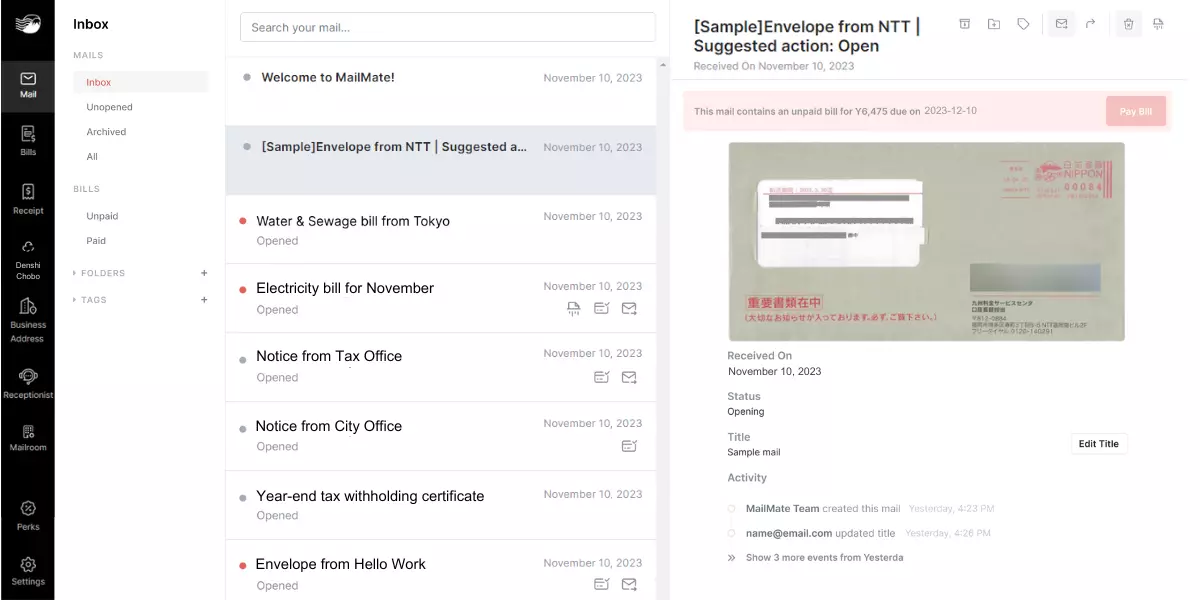
MailMate will receive your redirected mail to their scanning location, and your utility bills will be uploaded to your online dashboard. Click on the "Pay Bill" button, and MailMate staff will pay the bill on your behalf!
Frequently asked questions
How do I activate electricity in Japan?
To start using electricity in your new apartment or home, you must apply or call the electricity providers servicing your area. Depending on your area and building, someone might come to your residence to check the electricity meter and get your electricity switched on.
How much are utilities per month in Japan?
The average cost of utilities for someone in Japan can range from 6,000 yen to 12,000 yen, depending on where you live in Japan and the time of year.
How do you connect gas in Japan?
To start using gas in your new apartment or home, you must apply or call the gas providers servicing your area. Depending on your area and building, a staff member will come to check and activate your gas.
In closing
Setting up utilities in Japan is one of the first steps you'll take when transitioning into your new home.
If you need English support to get your electricity or gas turned on, consider using MailMate's property management services to help you move in with ease.
Aside from being your energy liason, MailMate can be your tax representative and serve as your domestic point of contact.
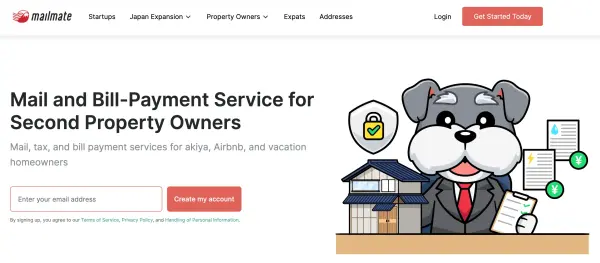
MailMate's property management service includes the following features:
Tax representative for annual real estate tax payments (required by law)
Domestic point of contact for authorities
Bill pay support for property tax payments
Tax notifications with English summaries
A virtual mailbox to receive the mail that arrives at your Japanese property
Manage important property documents and notifications in one place
Energy liaison, helping you connect to gas, electricity, and water
Other services MailMate offers include Internet setup of your Japanese property!
Founded in 2019, MailMate has simplified property ownership for foreigners living abroad and is an increasingly popular option recommended by users and well-known industry figures.

Additionally, if you use MailMate's tax representative service for property owners, MailMate will file the tax representative form with the relevant tax office on your behalf.
Spending too long figuring out your Japanese mail?
Virtual mail + translation services start at 3800 per month. 30-day money-back guarantee.

